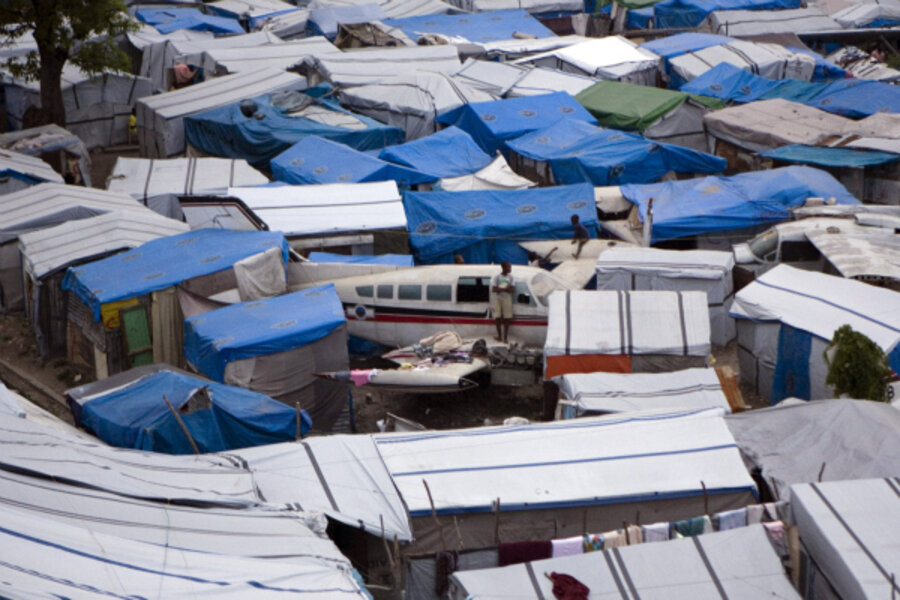Haiti's tent cities to bear worst of potential hurricane Tomas
Loading...
As tropical storm Tomas speeds toward Haiti, threatening to turn into a hurricane before it passes just west of the island Friday morning, some 1.3 million people are virtually trapped in Port-au-Prince’s flimsy tent cities.
In the countryside, hundreds of thousands more Haitians still live in tents following the 7.0 earthquake the leveled the capital and surrounding areas in January.
Authorities have advised anyone living in makeshift camps to seek refuge in sturdier buildings, but many say they don't have that option.
“The majority of people have nowhere to go,” says Stefan Reynier, the head of mission for Doctors Without Borders in Léogâne, 18 miles west of the capital. “Those people will not be protected.”
This is despite the fact that more than 100,000 homes in Port-au-Prince sit vacant and in need of only minimal repairs since an earthquake rocked the country in January, according to aid organizations in the country. Each home could be repaired with only days worth of work and several thousand dollars in supplies, they say.
The slow pace of postearthquake relief and reconstruction efforts has been on display for 10 months. Hundreds of thousands of Haitians have seen their situations unchanged since the weeks after the earthquake killed 300,000 people. The situation may now be reaching a head, with tropical storm Tomas approaching, thousands of people homeless, and a cholera outbreak threatening to spread nationwide, all while the country gears up for presidential elections in mere weeks.
Tent cities ordered to clear out
The National Hurricane Center (NHC) in Miami on Wednesday night issued a hurricane warning for the coast of Haiti. Tomas is expected to make landfall on Friday and dump 5 to 10 inches of rain across the island, according to the NHC.
Whatever the storm's incarnation, “it will create a bad situation for people living, and good conditions for cholera spreading in the water with the bad sanitation, with the movement of population,” adds Dr. Reynier.
The Haitian government has told citizens to evacuate their tent shelters and find secure housing – a tall order, considering the January earthquake damaged or destroyed some 200,000 homes in Port-au-Prince. Because of the city's poor drainage, streets strewn with rubble, and lack of trees or vegetation, flash floods could hit and rush through the dense tent camps.
“It’s a recipe for disaster,” says Michael Zamba, spokesman for the Pan American Development Foundation (PADF) in Washington, which has operated in Haiti for nearly 30 years.
120,000 homes easily repairable
Yet of those 200,000 damaged or destroyed homes, only 40 percent are irreparable, says Kit Miyamoto, the CEO of Miyamoto International, Structural and Earthquake Engineers (MI), which has been helping assess the city. Dr. Miyamoto notes that about 60 percent of them, or 120,000 homes, could easily be repaired with only days worth of work.
For the past 10 months, with funding from the World Bank and USAID and oversight from the Haitian Ministry of Public Works, homes across the capital have been inspected by workers from the United Nations, PADF, and MI. MI has also been training locals in masonry and structural engineering so they can repair the homes or rebuild new quake-proof buildings. So far, says Miyamoto, MI has trained 600 engineers and 300 masons – all Haitians, he says – with plans for training several thousand more masons.
"It's taken 10 months to basically get ready," he says in a telephone interview from Port-au-Prince. "It’s not like the Haitian people were ready to fix 100,000 buildings right after the earthquake."
No repairs until next year
A postearthquake structural expert with experience in China and Chile, Miyamoto estimates it will take 12 to 24 months to repair or reconstruct all 200,000 damaged or destroyed homes. That's assuming the money actually comes through from international donors who pledged billions of dollars but seem reluctant to actually open their wallets, he says. “By sometime early next year,” he says, “you will see reconstruction.”
Miyamoto defends the decision to train Haitians to fix the buildings, rather than bring in more international workers to do the job. “Haiti doesn’t want thousands of engineers to show up and do the work for them,” he says. “So we have to train local engineers.”
But at the same time, this decision has slowed relief efforts and left hundreds of thousands of people in the dense, unsanitary, and dangerous tent cities. Rape is widespread. And now, a hurricane is potentially about the bear down on the island.
Tomas picks up speed
Tropical storm Tomas was briefly downgraded Wednesday to a tropical depression, but wind speeds increased by 10 m.p.h. through the day to an average of 45 m.p.h. A tropical storm has wind speeds of 39 to 73 m.p.h., after which it reaches hurricane status. "Tomas is still forecast to slam into earthquake-ravaged Haiti as a hurricane late this week," the AccuWeather.com Weather Center said in a statement Wednesday.
West of Port-au-Prince in the city of Léogâne, Dr. Montlaux of Doctors Without Borders says that another 150,000 people are estimated to live in tents – nearly three-quarters of the local population. His 120-bed hospital, with about 40 staff, is the only medical center in all of Léogâne.
In addition to latching down the windows, he says hospital workers spent this week stocking up food, water, and medicine. A team of doctors was sent to the western tip of the island to treat potential victims of storm Tomas.
“Part of the preparation is not only to protect our things but to be of assistance right after the weekend,” he says. “We will have a large number of people who are affected. ... I would not be worried if everyone had a strong house where they could stay for the weekend."





